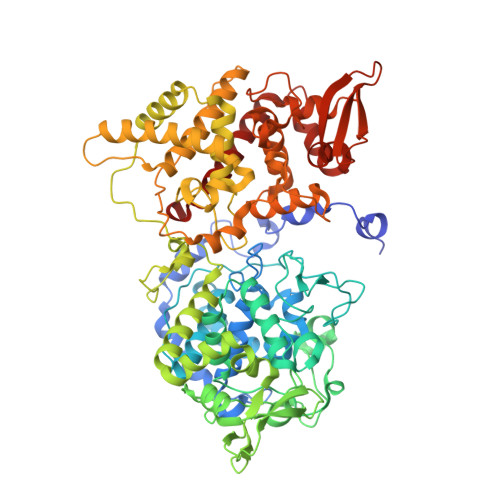Two alternative substrate paths for compound I formation and reduction in catalase-peroxidase KatG from Burkholderia pseudomallei.
Deemagarn, T., Wiseman, B., Carpena, X., Ivancich, A., Fita, I., Loewen, P.C.(2007) Proteins 66: 219-228
- PubMed: 17063492
- DOI: https://doi.org/10.1002/prot.21209
- Primary Citation of Related Structures:
5SX1, 5SX2 - PubMed Abstract:
Five residues in the multifunctional catalase-peroxidase KatG of Burkholderia pesudomallei are essential for catalase, but not peroxidase, activity. Asp141 is the only one of these catalase-specific residues not related with the covalent adduct found in KatGs that when replaced with a nonacidic residue reduces catalase activity to 5% of native levels. Replacing the nearby catalytic residue Arg108 causes a reduction in catalase activity to 35% of native levels, whereas a variant with both Asp141 and Arg108 replaced exhibits near normal catalase activity (82% of native), suggesting a synergism in the roles of the two residues in support of catalase activity in the enzyme. Among the Asp141 variants, D141E is unique in retaining normal catalase activity but with modified kinetics, suggesting more favorable compound I formation and less favorable compound I reduction. The crystal structure of the D141E variant has been determined at 1.8-A resolution, revealing that the carboxylate of Glu141 is moved only slightly compared with Asp141, but retains its hydrogen bond interaction with the main chain nitrogen of Ile237. In contrast, the low temperature ferric Electron Paramagnetic Resonance spectra of the D141A, R108A, and R108A/D141A variants are consistent with modifications of the water matrix and/or the relative positioning of the distal residue side chains. Such changes explain the reduction in catalase activity in all but the double variant R108A/D141A. Two pathways of hydrogen bonded solvent lead from the entrance channel into the heme active site, one running between Asp141 and Arg108 and the second between Asp141 and the main chain atoms of residues 237-239. It is proposed that binding of substrate H(2)O(2) to Asp141 and Arg108 controls H(2)O(2) access to the heme active site, thereby modulating the catalase reaction.
Organizational Affiliation:
Department of Microbiology, University of Manitoba, Winnipeg, Manitoba R3T 2N2, Canada.



















